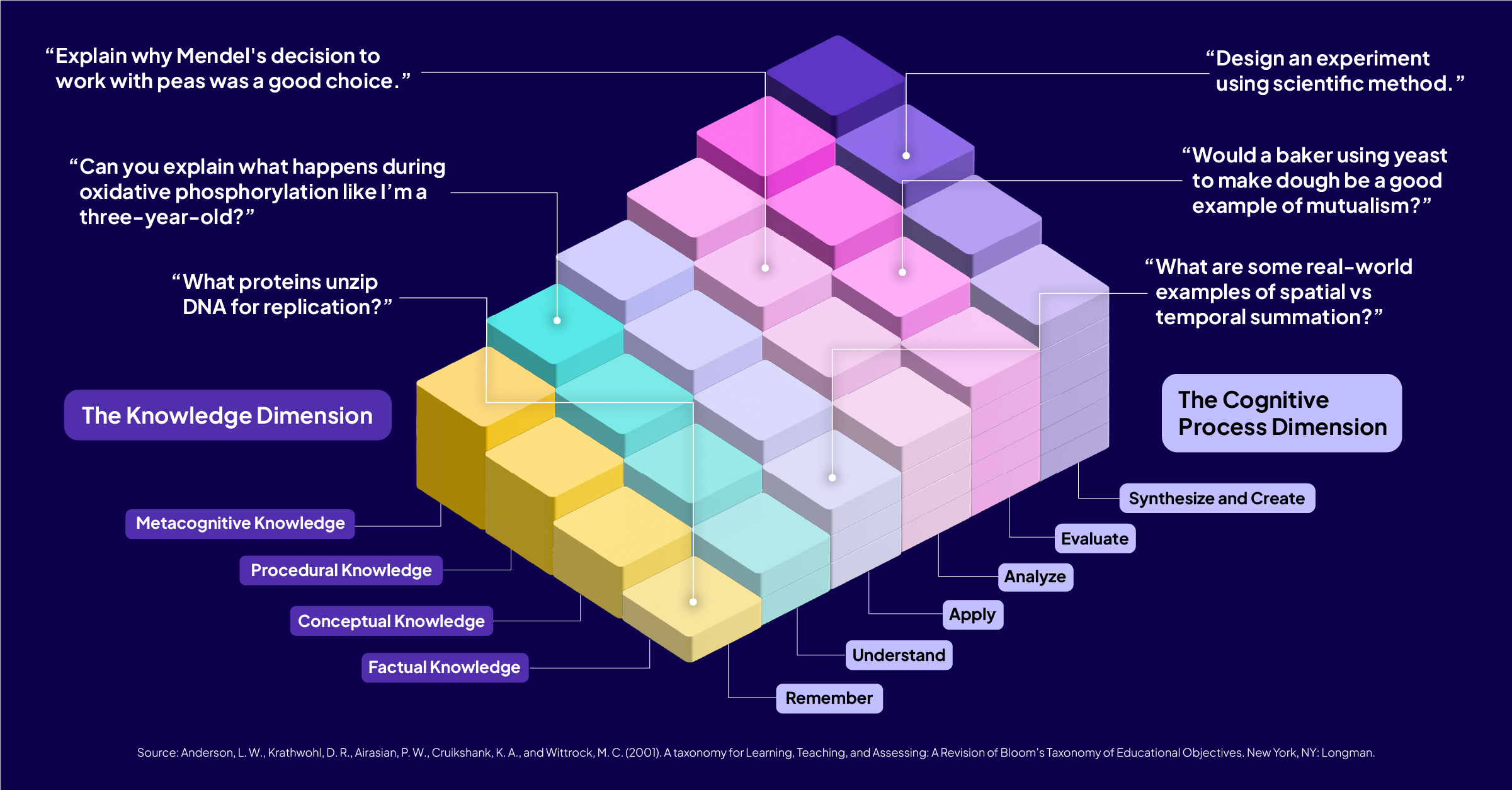
Drew Edwards, Pearson's Senior Director of Product Management for Pearson+
Understanding how students interact with AI tools provides invaluable insights into their learning processes. Ingesting knowledge is one thing; understanding, evaluating, refining, and applying it is another. Just as we expect students to think critically and learn deeper, we also push for it ourselves – in the products we create and the value we add to people’s learning experiences.
What we learned from students’ questions to AI
Over the last year, we’ve conducted analyses of over 128,000 student queries to the Explain function of Pearson’s AI study tools in Campbell Biology, the most popular title used in introductory biology courses. We categorized these student inputs using the revised Bloom’s Taxonomy (Anderson & Krathwohl, 2001) as a framework to understand the cognitive complexity of their questions. Bloom’s Taxonomy breaks learning into cognitive processes and knowledge types, ranging from simple to complex. We've taken real examples of student questions from this study to show how this works.
Using this framework to analyze the results, we saw that one-third of student queries were at higher levels of cognitive complexity, with 20% of student inputs reflecting the critical thinking skills essential for deeper learning. We were pleased to see students beginning to move beyond asking simply “What is this?” and into more complex territory.
Turning insights into innovation: Introducing "Go Deeper"
With these insights in mind, we've developed "Go Deeper," a new feature that builds on students' natural curiosity. “Go Deeper” functions as an enhancement to the Explain feature within our AI study tool, thoughtfully designed to scaffold learning, prompting students to continue their learning journey beyond their initial question.
Here's how it works: When a student asks a question, the tool provides a response and then suggests follow-up questions deliberately designed to be one or two levels higher in Bloom's Taxonomy. For example, if a student asks for a basic definition (Remember level), follow-up questions might encourage them to understand relationships between concepts or apply knowledge to new scenarios. This approach transforms a single question into a guided learning pathway that progressively builds critical thinking skills without jumping too far ahead and potentially confusing students.

"This research reinforces our commitment to product development backed by learning science," says Dr. Muireann Hendriksen, principal learning scientist at Pearson and lead author on this study. "By pairing how students formulate questions in their own words with an understanding of how students naturally engage with AI tools, we can create experiences that meet them where they are while encouraging deeper cognitive engagement. We're working to build educational experiences that genuinely help students learn and support them in achieving their desired outcomes."
AI as a learning partner, not a shortcut
The "Go Deeper" feature addresses a key challenge in education: Moving students beyond surface-level understanding to deeper, more meaningful learning that helps build important critical thinking skills. When students engage with progressively challenging questions, they're developing the critical thinking skills essential for success in education and beyond.
College students are increasingly adopting AI for use in their academic lives. As our latest Higher Ed Student AI Survey reveals, students trust AI tools built specifically by learning companies over generative AI overall. They recognize the value of tools designed with educational purposes in mind, and more than half now prefer learning tools that incorporate AI. As AI usage becomes more ubiquitous, the need for building learning experiences that utilize AI as a helpful study companion rather than a shortcut for easy answers that bypass knowledge building becomes all the more critical.
Pearson's application of generative AI is backed by learning science and vetted by subject matter experts. With over 80% of our products now digital or digitally enabled, Pearson is committed to the responsible application of AI to enhance the teaching and learning experience for educators, students, and employers.
Learn more about our analysis of student inputs in Pearson’s Asking to Learn report.
--
Read the Asking to Learn press release in our news section.


